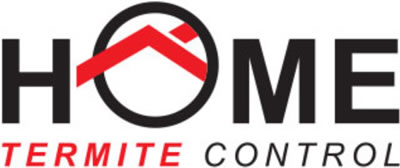Combatting termites requires an effective termite barrier, but which type suits your home best? This article examines the differences between chemical and physical barriers, illuminating costs and safety and determining which offers the most robust defence for long-term peace of mind.
Key Takeaways
- Termite protection can be achieved through chemical barriers, termiticides, or physical barriers, like mesh, crushed granite or products like Kordon. Sometimes, the effectiveness is enhanced when both are used in tandem.
- Termite infestations can be identified by subtle signs such as warped floorboards, softening timber, and unusual clicking sounds.
- Termite barriers, both chemical and physical, vary in cost and longevity but are considered cost-effective compared to the expense of repairing termite damage.
Understanding Termite Barriers: Chemical vs. Physical
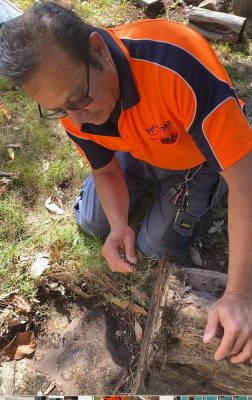
Imagine an invisible yet impenetrable fortress around your home, protecting it from termite attacks. That’s what an ideal termite barrier does. It’s a shield, a line of defence that keeps these destructive pests at bay. There are two main types of termite barriers: chemical and physical. Each type has its distinct characteristics and benefits.
Chemical barriers utilize potent termiticides to create an invisible lethal zone around your property, annihilating any invading termite. With chemical barriers installed, your property gains an added layer of protection. Conversely, physical barriers prevent concealed termite entry. A combination of both types is sometimes recommended where the termite pressure is extremely high.
Chemical Termite Barriers
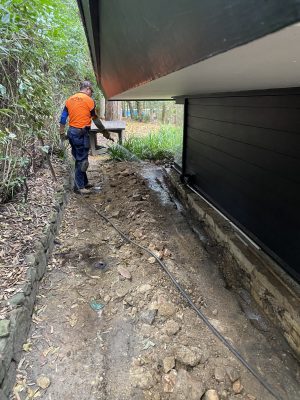
The chemical termite barrier is like the invisible moat around your castle, filled with termiticides. It’s an effective defence system that protects both new and existing structures. The modern barriers use eco-friendly chemicals such as Altriset. Altriset termiticide does not kill butterflies, honey bees or black ants but is still very effective against termites.
The application of a chemical termite barrier involves:
- Creating a trench around the property
- Saturating the trench with a termiticide
- The chemical bonds with the soil, forming a lethal zone fatal for any termite attempting to cross.
That being said, the installation is only half the story. Following the installation, conducting regular inspections and maintaining the barrier’s integrity is just as important.
Physical Termite Barriers
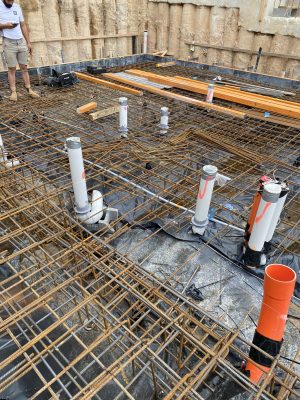
Physical termite barriers work by blocking termites using physical materials. These barriers can take various forms, including stainless steel mesh, termite-resistant collars, and sealants. Unlike their chemical counterparts, physical barriers are integrated into the building’s structure during construction, providing a continuous barrier that forces termites into open areas for easier detection.
Take for example the stainless steel mesh barriers, their efficacy comes from a finely woven structure that termites find impenetrable. They can be attached to slabs or masonry, providing a robust barrier against termites. Other options, like termite collars, safeguard hidden penetration points in slabs during construction.
Aggregates, although less commonly used, also serve as a physical barrier by utilizing crushed granite of specific sizes that termites cannot maneuver through.
Signs of a Termite Infestation: What to Look For
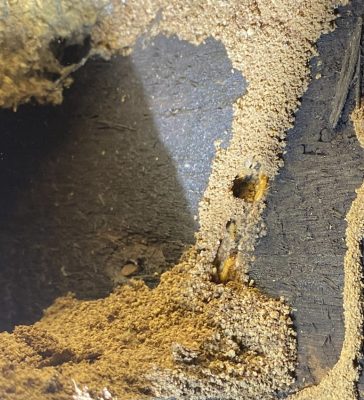
Early detection of a termite infestation could spare you significant financial and emotional distress. However, termites are masters of evasion, often leaving only subtle signs of their presence. So, what should you look for to uncover their hidden activities?
One of the earliest signs of a termite infestation is the presence of winged termites or swarmers. These are termites that have left their nest to start a new colony. If you see winged termites around lights on warm nights or in window tracks, it could signify a nearby nest and potential infestation.
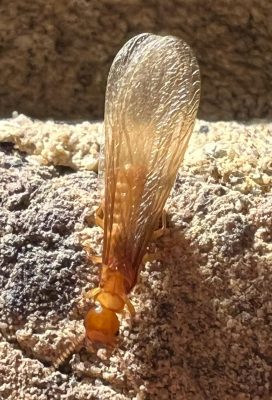
Termites often exhibit the following signs of presence:
- Filling cracks in timber with mud, which is a defensive measure to regulate their environment and prevent predator infiltration
- Softening or bubbling of painted timber
- Dark stains on internal walls
- Unusual clicking sounds from walls
These signs are indicative of a termite attack, specifically by subterranean termites.
Preventative Measures: How to Keep Termites at Bay
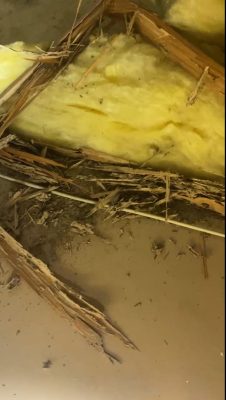
Preventing a termite infestation is much more beneficial than eliminating termite colonies after they have already infested your home. Some simple steps can make your home less attractive to these destructive pests.
Controlling moisture in your home is crucial for preventing termite infestations. This could involve fixing leaks, improving drainage, and ventilating crawl spaces. In addition, using plastic storage boxes instead of cardboard and ensuring proper ventilation of storage areas can deter termites.
Regular property maintenance, such as removing wood debris and ensuring that wood structures are not in contact with soil, can help with termite control and prevent termite infestations.
The Installation Process: What to Expect
The installation of a termite barrier demands precision and significant expertise. The method varies depending on whether you install a chemical or physical barrier.
The creation of chemical termite barriers involves:
- Digging a trench around the property
- Infusing the trench with a termiticide
- Letting the chemical bond with the soil to establish a lethal barrier
- Filling the trench with a chemical and water solution
- Creating a treated zone in the soil that is lethal to termites attempting to enter the area
On the other hand, installing a physical termite barrier involves tasks such as:
- Planning
- liaison with the builder
- installing before and after the concrete pour
- issuing certificate
The barrier covers the entire area under a concrete slab, ensuring all penetrations and perimeter is covered.
Costs and Longevity: Comparing Barrier Options
Despite the considerable investment, termite barriers are substantially economical compared to the cost of mending termite damage. The costs and longevity of termite barriers vary depending on the type of barrier and the extent of the infestation.
Chemical termite barriers can effectively protect a property for up to eight years, while physical barriers have a potential lifespan of up to 50 years. The cost of termite barrier treatments can range from three to several thousand dollars, influenced by the chosen system, property characteristics, and infestation severity.
Despite the upfront costs, the investment in a termite barrier is financially sound considering the high cost of termite damage, which averages $15,000 and typically isn’t covered by insurance.
Safety Concerns: Are Termite Barriers Safe for Your Family and Pets?
When installing termite barriers, safety remains a top priority. After all, the goal is to protect your home, not introduce new hazards. So, are termite barriers safe for your family and pets?
Modern chemical termite barriers:
- Make use of environmentally friendly and less hazardous chemicals.
- Bind to the soil without contaminating water sources.
- Are safe for children, pets, plants, and wildlife when used according to the label
- Pest control companies follow strict safety requirements and provide guidelines to ensure minimal exposure.
Choosing the Right Pest Control Company
Selecting a suitable pest control company is pivotal for effective termite protection. It’s about more than finding a company that can install termite barriers; you need a partner who appreciates the structure of your property and understands the risks to help you safeguard your home against termite attacks.
Factors to consider when choosing a pest control company include:
- experience
- reputation
- Licensing
- Warranties
Additionally, local knowledge of the area’s specific pest challenges can ensure the most effective and appropriate treatment for your home.
Regular Inspections: The Key to Ongoing Termite Protection
Even though termite barriers offer a formidable line of defence, they must be complemented with routine inspections to ensure optimal protection. Regular inspections help detect early signs of termite activity and prevent widespread damage.
Experts recommend having professional termite inspections at least annually or twice yearly in high-risk areas. Regular inspections are also essential for optimal protection and to honour the chemicals’ shelf life.
Summary
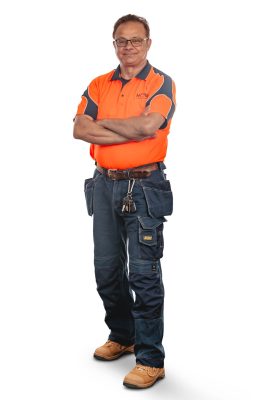
In conclusion, termite barriers are a crucial investment for any homeowner, providing a robust line of defence against these destructive pests. Whether chemical or physical, these barriers and regular inspections can prevent termite infestations and protect your home from costly damage. Take action today and secure your home against the silent destroyers.
Frequently Asked Questions
Do termite barriers work?
Yes, termite barriers can protect your home from termites, providing structural integrity. Physical barriers can prevent termites from CONSEALED entry to the property but may not offer the added benefit of controlling the termite colony.
What is the best barrier for termites?
Horses for courses! Depending on many factors. Due to the property’s structure, chemical barriers are sometimes not suited. Instead, termite baiting systems work best. In other cases, chemical termite barriers, such as Altriset or Termidor, provide long-term protection for your home.
What is the most popular termite chemical barrier?
The most popular termite chemical barriers are Altriset and Termidor, offering unparalleled advantages as a non-repellent treatment that potentially eliminates the entire colony over time.
How often should a termite barrier be done?
Depending on the chemical used, termite barrier should be done every 3-8 years.
Are white ants and termites the same?
Technically, they are the same, but the term “white ant” is often used due to misinformation or lay terms, whereas “termite” is the correct scientific name for these insects. Use the term “termite” when treating professionally.
